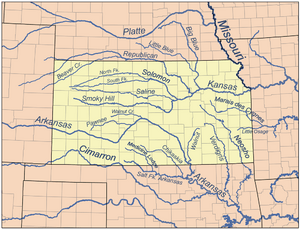List of rivers of Kansas facts for kids
Kansas is a state in the United States. It has many important rivers. This article lists the main rivers in Kansas. You will learn about where they flow and how big they are.
Contents
Where Rivers Flow: Drainage Basins
Rivers flow into larger rivers. These larger rivers then flow into even bigger ones. A "drainage basin" is like a giant bowl. All the water from rivers and streams in that bowl flows to one main river. Here are the rivers in Kansas, grouped by their drainage basin. Smaller rivers that flow into bigger ones are indented.
Mississippi River Basin
The Mississippi River is one of the longest rivers in the world. Many rivers in Kansas eventually flow into it.
Arkansas River Basin
The Arkansas River is a major river in the central United States. Many Kansas rivers join it.
- Arkansas River
- Neosho River
- Verdigris River
- Cimarron River
- Salt Fork Arkansas River
- Grouse Creek
- Walnut River
- Little Walnut River
- Whitewater River
- Ninnescah River
- Little Arkansas River
- Cow Creek
- Rattlesnake Creek
- Walnut Creek
- Pawnee River
- Buckner Creek
- Bear Creek
Missouri River Basin
The Missouri River is the longest river in North America. Many Kansas rivers flow into it.
- Missouri River
- Osage River (MO) (This river is mostly in Missouri, but some Kansas rivers flow into it.)
- Blue River
- Kansas River
- Stranger Creek
- Wakarusa River
- Delaware River
- Mission Creek
- Big Blue River
- Black Vermillion River
- Little Blue River
- Indian Creek
- Republican River
- Buffalo Creek
- White Rock Creek
- Prairie Dog Creek
- Sappa Creek
*Beaver Creek **Little Beaver Creek
*North Fork Solomon River *South Fork Solomon River
-
-
-
- Saline River
- Big Creek
- Hackberry Creek
- Ladder Creek
- North Fork Smoky Hill River
-
- Wolf River
- Big Nemaha River
-
Rivers in Alphabetical Order
Here is a list of the main rivers in Kansas, arranged from A to Z.
- Arikaree River
- Arkansas River
- Beaver Creek
- Big Blue River
- Big Creek
- Big Nemaha River
- Black Vermillion River
- Blue River
- Brush Creek
- Buckner Creek
- Buffalo Creek
- Caney River
- Chikaskia River
- Cimarron River
- Cottonwood River
- Cow Creek
- Delaware River
- Elk River
- Fall River
- Grouse Creek
- Hackberry Creek
- Kansas River
- Ladder Creek
- Little Arkansas River
- Little Beaver Creek
- Little Blue River
- Little Osage River
- Little Walnut River
- Marais des Cygnes River
- Marmaton River
- Medicine Lodge River
- Mission Creek
- Missouri River
- Neosho River
- Ninnescah River
- North Fork Ninnescah River
- North Fork Smoky Hill River
- North Fork Solomon River
- Pawnee River
- Prairie Dog Creek
- Rattlesnake Creek
- Republican River
- Saline River
- Salt Fork Arkansas River
- Sappa Creek
- Shoal Creek
- Smoky Hill River
- Solomon River
- South Fork Ninnescah River
- South Fork Republican River
- South Fork Solomon River
- Spring River
- Stranger Creek
- Verdigris River
- Wakarusa River
- Walnut Creek
- Walnut River
- White Rock Creek
- Whitewater River
- Wolf River
How Big Are the Rivers?
Rivers carry different amounts of water. We can measure how much water flows past a certain point in one second. This is called "mean flow." It is measured in "cubic feet per second" (cfs). Imagine a box that is one foot long, one foot wide, and one foot high. That's one cubic foot of water. The table below shows the average flow for some Kansas rivers.


